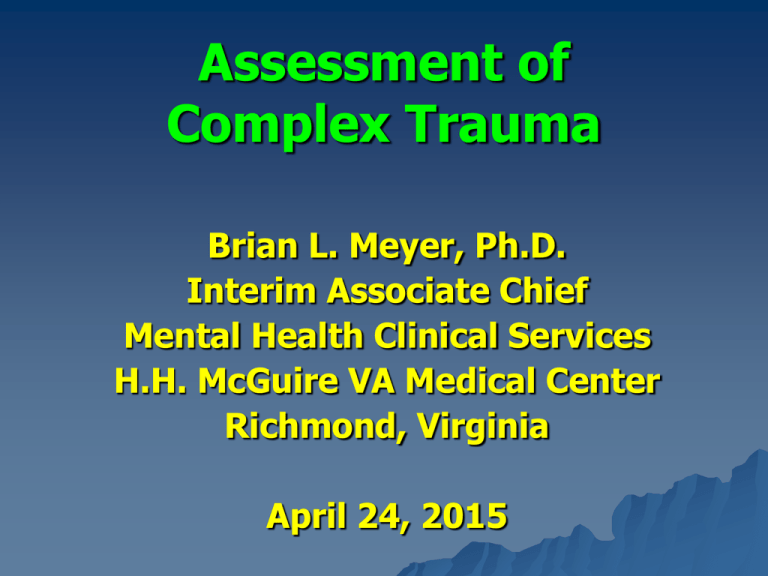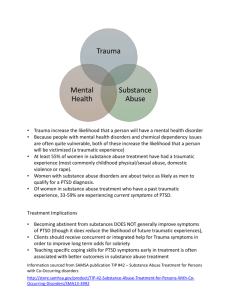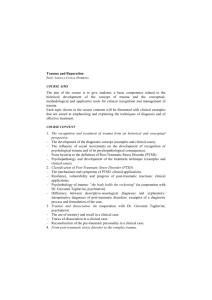
Assessment of
Complex Trauma
Brian L. Meyer, Ph.D.
Interim Associate Chief
Mental Health Clinical Services
H.H. McGuire VA Medical Center
Richmond, Virginia
April 24, 2015
Disclaimer
The views expressed in this
presentation are solely those of
the presenter and do not
represent those of the United
States government.
Trauma and PTSD
Prevalence of PTSD
More
men (61%) than women (51%)
experience a trauma at some point in their
lives, but women experience PTSD at
twice the rate of men (10% vs. 5%) (Kessler
et al., 1995; Tolin and Foa, 2006)
Post-Traumatic
Stress Disorder
PTSD is characterized by:
Exposure to a severe lifethreatening event
Repetitive re-experiencing of the
LT event
Avoidance of stimuli associated
with trauma
Negative mood and cognitions
Increased arousal
Trauma and PTSD
Not
all trauma leads to PTSD
Depending on the study, the type of
trauma, and the group studied, 3%-58%
get PTSD
Not all abuse leads to PTSD
LIFE-THREATENING EVENTS
IMPERSONAL
TRAUMATIC
PERSONAL
Many Types of Trauma
Combat and warzone trauma
Rape
Child physical
abuse
Child sexual abuse
Domestic violence
Accidents
Natural disasters
Torture
Being held hostage
Environmental
trauma
Genocide
Fires
Who Gets PTSD?
It
depends on:
Severity
Duration
Proximity
PTSD
is mitigated or worsened by:
Childhood experience
Personality characteristics
Family history
Social support
Other Common Psychiatric
Diagnoses in People Exposed
to Traumatic Events
Dysthymic
Disorder
Major Depressive Disorder
Mood Disorder NOS
Bipolar Disorder
Generalized Anxiety Disorder
Phobic Disorder
Panic Disorder
More Common Psychiatric
Diagnoses in People Exposed
to Traumatic Events
ADHD
Oppositional Defiant Disorder
Conduct Disorder
Reactive Attachment Disorder
Borderline Personality Disorder
Antisocial Personality Disorder
Narcissistic Personality Disorder
Complex Trauma
What is Complex Trauma?
Complex psychological trauma results
from “exposure to severe stressors
that (1) are repetitive or prolonged,
(2) involve harm or abandonment by
caregivers or other ostensibly
responsible adults, and (3) occur at
developmentally vulnerable times in
the victim’s life.” Ford and Courtois, 2009
What is Complex Trauma?
The psychological effects of chronic and
cumulative traumas
Results from interpersonal victimization,
multiple traumatic events, and/or
traumatic exposure of prolonged duration
–
–
–
–
–
–
Sexual and physical abuse
Domestic violence
Ethnic cleansing
Prisoners of war
Torture
Being held hostage
What is Complex Trauma?
Complex trauma is often relational
Trauma creates vulnerability to further
trauma: adults who are traumatized may
have been traumatized previously as
children
Rates of PTSD for
Simple vs. Complex Trauma
Simple
Complex
10-20%
33-75%
Copeland et al., 2007; Kessler et al., 1995
What Are Complex
Traumatic Stress Disorders?
The
sequelae of complex trauma
Also known as Complex PTSD, or CPTSD
People at Risk of Developing Complex
Traumatic Stress Disorders
Economically impoverished inner city minorities
Incarcerated individuals
Homeless persons
Sexually and physically revictimized children or
adults
Victims of genocide or torture
Developmentally, intellectually, or psychiatrically
challenged persons
Civilian workers and soldiers harassed on the job
or in the ranks
Emergency responders
Vogt et al., 2007
Core Problems
in Complex Trauma
Affect
dysregulation
Dissociation
Somatic dysregulation
Impaired self-concept
Disorganized attachment patterns
In addition to symptoms of PTSD and
other comorbid disorders
Ford and Courtois, 2009
Disorders of Extreme Stress Not
Otherwise Specified (DESNOS)
A. Alterations in regulating affect arousal
– Persistent dysphoria
– Difficulty modulating anger
– Self-injurious behavior
– Suicidal preoccupation
– Difficulty modulating sexual involvement
– Addictive behavior
B. Alterations in attention and consciousness
– Amnesia
– Dissociation
– Depersonalization/derealization
Herman, 1992, and Courtois, 2004
Disorders of Extreme Stress Not
Otherwise Specified (DESNOS)
C. Alterations in self-perception
– Chronic guilt, intense shame, and self-blame
– Helplessness
– Sense of defilement
– Sense of being completely different from others
D. Alterations in perception of perpetrator
– Preoccupation with relationship with perpetrator
– Unrealistic attribution of total power to
perpetrator
– Idealization or gratitude
– Sense of special relationship
– Acceptance of belief system of perpetrator
Herman, 1992, and Courtois, 2004
Disorders of Extreme Stress Not
Otherwise Specified (DESNOS)
E. Alterations in relationships with others
– Isolation and withdrawal
– Inability to trust others
– Inability to feel intimate
– Repeated search for rescuer
– Repeated failures of self-protection
F. Somatic and/or medical conditions
– Involving all major body systems
– Chronic pain
Herman, 1992, and Courtois, 2004
Disorders of Extreme Stress Not
Otherwise Specified (DESNOS)
G. Alterations in systems of meaning
– Loss of sustaining faith
– Sense of hopelessness and despair
Note: Some of these symptoms were
included in DSM IV as associated features
of PTSD
Herman, 1992, and Courtois, 2004
Experiencing Complex Trauma
Emotional instability
Overwhelming feelings of
rage, guilt, shame, despair,
ineffectiveness and/or
hopelessness
Tension reduction activities
such as self-mutilation,
compulsive sexual behavior,
and bulimia
Suicidal or violent behavior
Dissociation
Experiencing Complex Trauma
Loss of a sense of trust, safety, and
self-worth
Loss of a coherent sense of self
Belief of being bad or unlovable
Insecure attachments/damaged
interpersonal relationships
Difficulty functioning in social
settings, including work
Loss of faith
Enduring personality changes
Complex Trauma:
A Case Example
Mr. M.: Physically and emotionally
abused by mother and stepfather,
went to Vietnam to “kill”, multiple
divorces, polysubstance abuse, lost
career and imprisoned, dissociated
experience of killing children in war,
remembered “the laughter of
children”, became suicidal, referred
for treatment
Complex PTSD May be
Confused With:
PTSD
ADHD
Other
anxiety disorders
Bipolar Disorder
Mood Disorder NOS
Psychotic Disorder NOS
Reactive Attachment Disorder
Complex PTSD Often Appears
as or Co-Occurs with:
PTSD
Other Anxiety Disorders
Mood Disorders
Behavior Disorders,
especially ADHD
Substance Use Disorders
Co-morbidity is the rule
Complex PTSD Is Conceptually
Related to:
Anxiety Disorders
Dissociative Disorders
Somatization Disorders
Personality Disorders
That is why DSM 5
places trauma in a new
category entitled
Trauma and StressorRelated Disorders
Complex PTSD Is Much
More Than Simple PTSD
Loss of a coherent sense of self
Problems in self-regulation
Tendency to be revictimized
Other mental health disorders
Substance use disorders
Health problems
Relationship problems
Changes in systems of belief and
meaning
Changes to PTSD
Diagnosis in DSM 5
Addition of new criteria involving
negative cognitions (negative beliefs
about the world, blame of self or others
for the trauma) and mood (anxiety,
anger, guilt)
Addition of a new arousal criterion:
self-destructive or reckless behavior
Addition of a dissociative subtype
These changes result in approximately
the same number of people who will
meet criteria for a diagnosis of PTSD
They also move PTSD closer to the
definition of Complex Trauma
Complex Trauma and Health:
The Adverse Childhood
Events Study
17,421 adult patients of Kaiser
Permanente
Came out of an obesity program: many
dropouts who lost weight believed that it
protected them (against further sexual
abuse, against violence from prisoners)
Eight categories of events in the home:
physical abuse, emotional abuse, sexual
abuse, someone imprisoned, domestic
violence, substance abuse, chronic mental
illness, and loss of parent
Felitti, Anda, et al., 1998
Complex Trauma and
Health: The ACE Study
Results more than 50 years later:
More than 1/2 of population experienced
one or more ACEs; 1/4 had two or more
Exposure to one category increases
likelihood of exposure to another by 80%
The higher the ACE score, the worse the
health problems
Felitti, Anda, et al., 1998
Complex Trauma and
Health: The ACE Study
Results:
Greater likelihood of health problems:
–
–
–
–
–
–
–
–
Chronic obstructive pulmonary disease
Hepatitis
Sexually transmitted diseases
Obesity
Heart disease
Fractures
Diabetes
Unintended pregnancies
Felitti, Anda, et al., 1998
Complex Trauma and
Health: The ACE Study
Results:
Greater likelihood of behavioral health
problems:
–
–
–
–
–
Smoking
Intravenous drug abuse
Depression
Attempted suicide
Alcoholism
Felitti, Anda, et al., 1998
The ACE Study:
A Dose-Response Curve
Complex Trauma and
Health: The ACE Study
Results:
Greater likelihood of occupational
problems:
– Occupational health
– Poor job performance
Felitti, Anda, et al., 1998
THE CATALYZING EFFECT OF COMPLEX TRAUMA
Health
Problems
Substance Abuse
Problems
Traumatic
Experiences
Mental Health
Problems
Criminal
Behavior
Relationship
Problems
Employment
Problems
Complex Traumatic
Stress Disorders
Recognizing
complex trauma allows
therapists to:
– Develop greater empathy and
understanding
– Gain distance from difficult and
noncompliant behaviors
– Anticipate obstacles to building and
maintaining therapeutic alliances
– Identify non-PTSD targets for
intervention
Newman, Orsillo et al., 1995
Resources
Trauma and Recovery, 1992, Judith Herman
Luxenberg, T., Spinazzola, J., and van der
Kolk, B. (2005). Complex Trauma and
Disorders of Extreme Stress (DESNOS)
Diagnosis, Part One: Assessment (2005).
Directions in Psychiatry, 21, 373-393.
http://www.nctsn.org/traumatypes/complex-trauma/assessment
www.acestudy.org
Contact:
Brian L. Meyer, Ph.D.
Brian.Meyer@va.gov








